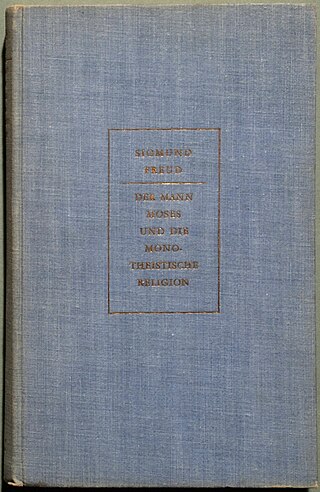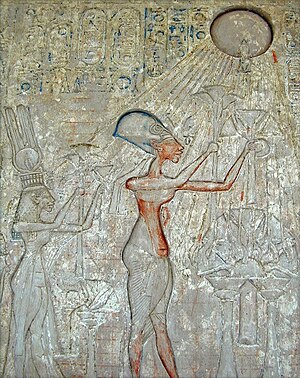
Aten also Aton, Atonu, or Itn was the focus of Atenism, the religious system formally established in ancient Egypt by the late Eighteenth Dynasty pharaoh Akhenaten. Exact dating for the 18th dynasty is contested, though a general date range places the dynasty in the years 1550 to 1292 B.C.E. The worship of Aten and the coinciding rule of Akhenaten are major identifying characteristics of a period within the 18th dynasty referred to as the Amarna Period.

Amarna is an extensive ancient Egyptian archaeological site containing the remains of what was the capital city during the late Eighteenth Dynasty. The city of Akhetaten was established in 1346 BC, built at the direction of the Pharaoh Akhenaten, and abandoned shortly after his death in 1332 BC. The name that the ancient Egyptians used for the city is transliterated as Akhetaten or Akhetaton, meaning "the horizon of the Aten".

Akhenaten, also spelled Akhenaton or Echnaton, was an ancient Egyptian pharaoh reigning c. 1353–1336 or 1351–1334 BC, the tenth ruler of the Eighteenth Dynasty. Before the fifth year of his reign, he was known as Amenhotep IV.

Nefertiti was a queen of the 18th Dynasty of Ancient Egypt, the great royal wife of Pharaoh Akhenaten. Nefertiti and her husband were known for their radical overhaul of state religious policy, in which they promoted the earliest known form of monotheism, Atenism, centered on the sun disc and its direct connection to the royal household. With her husband, she reigned at what was arguably the wealthiest period of ancient Egyptian history. After her husband's death, some scholars believe that Nefertiti ruled briefly as the female king known by the throne name, Neferneferuaten and before the ascension of Tutankhamun, although this identification is a matter of ongoing debate. If Nefertiti did rule as Pharaoh, her reign was marked by the fall of Amarna and relocation of the capital back to the traditional city of Thebes.
Monolatry is the belief in the existence of many gods, but with the consistent worship of only one deity. The term monolatry was perhaps first used by Julius Wellhausen.

Kiya was one of the wives of the Egyptian Pharaoh Akhenaten. Little is known about her, and her actions and roles are poorly documented in the historical record, in contrast to those of Akhenaten's 'Great royal wife', Nefertiti. Her unusual name suggests that she may originally have been a Mitanni princess. Surviving evidence demonstrates that Kiya was an important figure at Akhenaten's court during the middle years of his reign, when she had a daughter with him. She disappears from history a few years before her royal husband's death. In previous years, she was thought to be mother of Tutankhamun, but recent DNA evidence suggests this is unlikely.

Meritaten, also spelled Merytaten, Meritaton or Meryetaten, was an ancient Egyptian royal woman of the Eighteenth Dynasty of Egypt. Her name means "She who is beloved of Aten"; Aten being the sun-deity whom her father, Pharaoh Akhenaten, worshipped. She held several titles, performing official roles for her father and becoming the Great Royal Wife to Pharaoh Smenkhkare, who may have been a brother or son of Akhenaten. Meritaten also may have served as pharaoh in her own right under the name Ankhkheperure Neferneferuaten.

Atenism, also known as the Aten religion, the Amarna religion, and the Amarna heresy, was a religion in ancient Egypt. It was founded by Akhenaten, a pharaoh who ruled the New Kingdom under the Eighteenth Dynasty. The religion is described as monotheistic or monolatristic, although some Egyptologists argue that it was actually henotheistic. Atenism was centred on the cult of Aten, a god depicted as the disc of the Sun. Aten was originally an aspect of Ra, Egypt's traditional solar deity, though he was later asserted by Akhenaten as being the superior of all deities. In the 14th century BC, Atenism was Egypt's state religion for around 20 years, and Akhenaten met the worship of other gods with persecution; he closed many traditional temples, instead commissioning the construction of Atenist temples, and also suppressed religious traditionalists. However, subsequent pharaohs toppled the movement in the aftermath of Akhenaten's death, thereby restoring Egyptian civilization's traditional polytheistic religion. Large-scale efforts were then undertaken to remove from Egypt and Egyptian records any presence or mention of Akhenaten, Atenist temples, and assertions of a uniquely supreme god.
The Amarna Period was an era of Egyptian history during the later half of the Eighteenth Dynasty when the royal residence of the pharaoh and his queen was shifted to Akhetaten in what is now Amarna. It was marked by the reign of Amenhotep IV, who changed his name to Akhenaten in order to reflect the dramatic change of Egypt's polytheistic religion into one where the sun disc Aten was worshipped over all other gods. The Egyptian pantheon was restored under Akhenaten's successor, Tutankhamun.

Psalm 104 is the 104th psalm of the Book of Psalms, beginning in Hebrew "ברכי נפשי" ; in English in the King James Version: "Bless the LORD, O my soul. O LORD my God, thou art very great". In the slightly different numbering system used in the Greek Septuagint and the Latin Vulgate version of the Bible, this psalm is Psalm 103. In Latin, it is known as "Benedic anima mea Domino".

Amarna art, or the Amarna style, is a style adopted in the Amarna Period during and just after the reign of Akhenaten in the late Eighteenth Dynasty, during the New Kingdom. Whereas ancient Egyptian art was famously slow to change, the Amarna style was a significant and sudden break from its predecessors both in the style of depictions, especially of people, and the subject matter. The artistic shift appears to be related to the king's religious reforms centering on the monotheistic or monolatric worship of the Aten, the disc of the Sun, as giver of life.

Moses and Monotheism is a 1939 book about the origins of monotheism written by Sigmund Freud, the founder of psychoanalysis. It is Freud's final original work and it was completed in the summer of 1939 when Freud was, effectively speaking, already "writing from his death-bed." It appeared in English translation the same year.

Meketaten was the second of six daughters born to the Egyptian Pharaoh Akhenaten and his Great Royal Wife Nefertiti. She likely lived between Year 4 and Year 14 of Akhenaten's reign. Although little is known about her, she is frequently depicted with her sisters accompanying her royal parents in the first two-thirds of the Amarna Period.

The Great Temple of the Aten was a temple located in the city of el-Amarna, Egypt. It served as the main place of worship of the deity Aten during the reign of the 18th Dynasty pharaoh Akhenaten. Akhenaten ushered in a unique period of ancient Egyptian history by establishing the new religious cult dedicated to the sun-disk Aten, originally an aspect of Ra, the sun god in traditional ancient Egyptian religion. The king shut down traditional worship of other deities like Amun-Ra, and brought in a new era, though short-lived, of seeming monotheism where the Aten was worshipped as a sun god and Akhenaten and his wife, Nefertiti, represented the divinely royal couple that connected the people with the god. Although he began construction at Karnak during his rule, the association the city had with other gods drove Akhenaten to establish a new city and capital at Amarna for the Aten. Akhenaten built the city along the east bank of the Nile River, setting up workshops, palaces, suburbs and temples. The Great Temple of the Aten was located just north of the Central City and, as the largest temple dedicated to the Aten, was where Akhenaten fully established the proper cult and worship of the sun-disk.
Ahmed Osman is an Egyptian-born author. He has put forward a number of theories, some revisionist in nature, about Ancient Egypt and the origins of Islam, Judaism and Christianity.
The North City was an administrative area in the ancient Egyptian city of Amarna in Upper Egypt, the short-lived capital of Pharaoh Akhenaten of the 18th Dynasty. It contains the ruins of royal palaces, especially the Northern Palace and other administrative buildings and occupies an area between the river and the cliffs that terminate the plains to the north of the city itself.
Amun was a major ancient Egyptian deity who appears as a member of the Hermopolitan Ogdoad. Amun was attested from the Old Kingdom together with his wife Amunet. With the 11th Dynasty, Amun rose to the position of patron deity of Thebes by replacing Montu.

Amarna Tomb 3 is a rock-cut cliff tomb located in Amarna, Upper Egypt. The tomb belonged to the Ancient Egyptian noble Ahmes (Ahmose), who served during the reign of Akhenaten. The tomb is situated at the base of a steep cliff and mountain track at the north-eastern end of the Amarna plains. It is located in the northern side of the wadi that splits the cluster of graves known collectively as the Northern tombs. Amarna Tomb 3 is one of six elite tombs belonging to the officials of Akhenaten. It was one of the first Northern tombs, built in Year 9 of the reign of Akhenaten.
'Ancient Egyptian philosophy' is a term used by some authors to refer to ancient Egyptian literature which is considered to have a philosophical aspect, commonly referred to as 'wisdom literature'. There is some debate regarding its true scope and nature.
The Exodus is the founding myth of the Israelites. The scholarly consensus is that the Exodus, as described in the Torah, is not historical, even though there may be a historical core behind the Biblical narrative.















